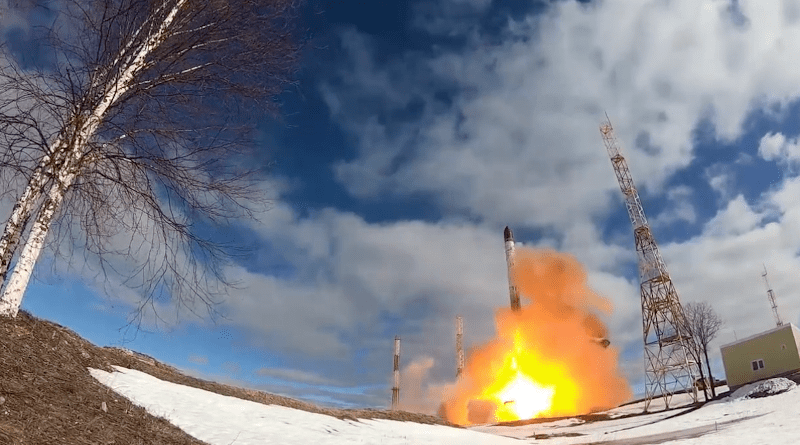The Salient Features Of The Tenth NPT Review Conference 2022 – OpEd
By Sher Bano
After four weeks of speeches, debates and closed-door negotiations on the 1968 Nuclear Non-Proliferation Treaty (NPT), diplomats from 151 countries failed to reach consensus on a conference document designed to review and strengthen implementation of the treaty due to Russian objections to language addressing the nuclear security crisis at Ukraine’s Zaporizhzhia nuclear power plant, which was seized by Russia in March. Daryl G. Kimball (executive director of the Arms Control Association) said that the NPT is often called the cornerstone of nuclear non-proliferation and global disarmament, but the debate and the results of this meeting reveal that there are cracks in the foundations of the treaty and deep divisions between states with nuclear weapons.
The purpose of the NPT conference was to enhance compliance with the Treaty on the Non-Proliferation of Nuclear Weapons and to enhance global security by effectively addressing the nuclear arms race and the growing threat of nuclear weapons use. The conference focused on measures taken for disarmament by stressing on agreement to unconditional action within a specified timeframe. The Russian Federation and the United States committed to continuing negotiations on successive framework to the New START Treaty before it comes to end in 2026; and hereby, adhere to the implementation of the New START in letter and spirit at present. In the wake of rising tensions between Russia and the U.S. following Putin’s war on Ukraine, the US and Russia have pledged to participate in nuclear arms control talks aimed at establishing reasonable and effective limits on their largest nuclear weapons which marks a significant effort towards retention of the nuclear arms control agreement.
However, on other disarmament issues, the conference was unable to secure agreement on specific action steps. Diplomats from the five nuclear-weapon states (China, France, Russia, the United Kingdom and the United States) rejected pragmatic proposals for specific, time-bound commitments to fulfill their NPT disarmament obligations. The nuclear-weapon states failed to come up with new, creative but realistic ideas and the necessary political will to meet those obligations, but instead came with every intention of evading when pressed about their lack of progress towards nuclear disarmament.
As conference time ran out, many states parties expressed dissatisfaction with numerous elements of the August 25 draft outcome document, but chose not to oppose the consensus. Many non-nuclear weapon states were justifiably upset with the lack of ambition specificity on nuclear disarmament issues. At the 2010 review conference, the NPT nuclear-weapon states pledged to “accelerate concrete progress on steps leading to nuclear disarmament,” including “all types of nuclear weapons,” as well as to work hard toward the entry into force of the 1996 Agreement Comprehensive Test Ban Treaty (CTBT). Article VI of the NPT commits the States parties to “continue negotiations in good faith on effective measures relating to the cessation of the nuclear arms race at an early date and to nuclear disarmament.
In the draft document of the conference, the NPT states parties expressed their deep concern about the lack of tangible progress in further reductions in world stocks and in the implementation of disarmament commitments by the nuclear-weapon states since the 2015 Review Conference. But noticing such a lack of progress does not replace commitment to actions that actually lead to stopping and reversing the nuclear arms race. Not surprisingly, the NPT nuclear-weapon states also resisted calls by non-nuclear-weapon states to unequivocally condemn recent threats to use nuclear weapons, such as those issued on February 24 and April 27 by Russia against any state that might interfere with its policy invasion of Ukraine.
In the NPT Review Conference draft outcome document, nuclear-weapon states would only commit to refrain from any inflammatory rhetoric on the use of nuclear weapons. At the beginning of the NPT conference, France, the United Kingdom and the United States issued a working document that attempted to distinguish between “irresponsible” offensive nuclear threats from Russia and “responsible” nuclear threats for “defensive” purposes of their own nations. The Russian delegation defended what it called Russia’s nuclear “warnings” as simply part of Moscow’s nuclear deterrence strategy.
In contrast, the states parties to the 2017 Treaty on the Prohibition of Nuclear Weapons (TPNW) issued a strong consensus political declaration on June 23 at the first meeting of the state parties to the TPNW. That declaration states that any use or threat of use of nuclear weapons is a violation of international law, including the Charter of the United Nations. The TPNW statement further condemned unequivocally any and all nuclear threats, whether explicit or implied and regardless of the circumstances.
The main committee’s draft report reiterates the importance of commitment to the key principles of the NPT, such as nuclear arms reduction, complete and total disarmament, and the peaceful uses of nuclear energy. However, the fundamental challenge remains the lack of urgency to address the growing nuclear threats, as well as the absence of timelines and concrete action points. A key conclusion that emerges is the focus on the aspect of humanitarian consequences, as well as actionable points, such as the New START successor framework, as well as the possible implementation of a reporting mechanism within the NPT.
The writer is working as Research Officer at Strategic Vision Institute (SVI), a non-partisan think- tank based out of Islamabad, Pakistan

